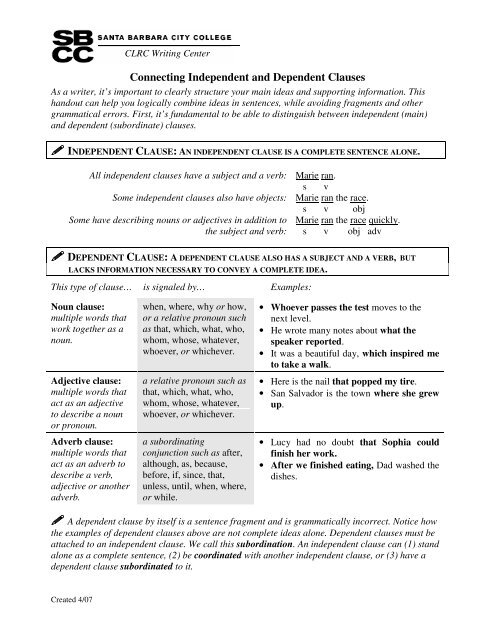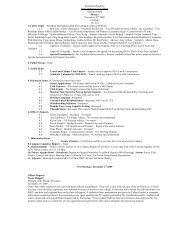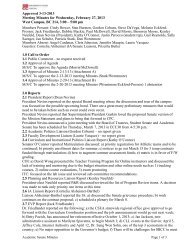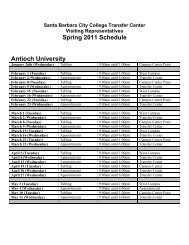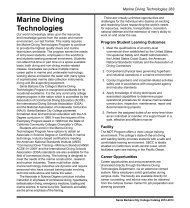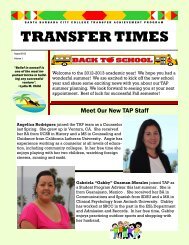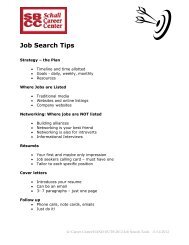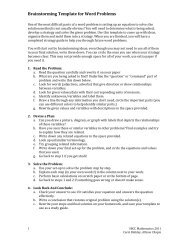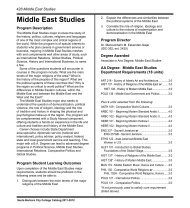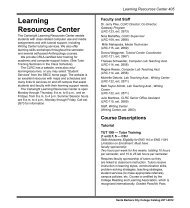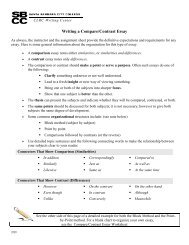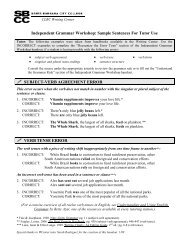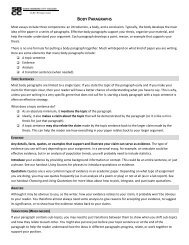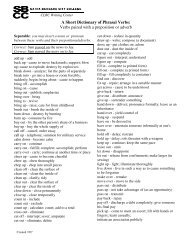Connecting Independent and Dependent Clauses
Connecting Independent and Dependent Clauses
Connecting Independent and Dependent Clauses
Create successful ePaper yourself
Turn your PDF publications into a flip-book with our unique Google optimized e-Paper software.
CLRC Writing Center<br />
<strong>Connecting</strong> <strong>Independent</strong> <strong>and</strong> <strong>Dependent</strong> <strong>Clauses</strong><br />
As a writer, it’s important to clearly structure your main ideas <strong>and</strong> supporting information. This<br />
h<strong>and</strong>out can help you logically combine ideas in sentences, while avoiding fragments <strong>and</strong> other<br />
grammatical errors. First, it’s fundamental to be able to distinguish between independent (main)<br />
<strong>and</strong> dependent (subordinate) clauses.<br />
INDEPENDENT CLAUSE: AN INDEPENDENT CLAUSE IS A COMPLETE SENTENCE ALONE.<br />
All independent clauses have a subject <strong>and</strong> a verb: Marie ran.<br />
s v<br />
Some independent clauses also have objects: Marie ran the race.<br />
s v obj<br />
Some have describing nouns or adjectives in addition to Marie ran the race quickly.<br />
the subject <strong>and</strong> verb: s v obj adv<br />
DEPENDENT CLAUSE: A DEPENDENT CLAUSE ALSO HAS A SUBJECT AND A VERB, BUT<br />
LACKS INFORMATION NECESSARY TO CONVEY A COMPLETE IDEA.<br />
This type of clause… is signaled by… Examples:<br />
Noun clause:<br />
multiple words that<br />
work together as a<br />
noun.<br />
Adjective clause:<br />
multiple words that<br />
act as an adjective<br />
to describe a noun<br />
or pronoun.<br />
Adverb clause:<br />
multiple words that<br />
act as an adverb to<br />
describe a verb,<br />
adjective or another<br />
adverb.<br />
when, where, why or how,<br />
or a relative pronoun such<br />
as that, which, what, who,<br />
whom, whose, whatever,<br />
whoever, or whichever.<br />
a relative pronoun such as<br />
that, which, what, who,<br />
whom, whose, whatever,<br />
whoever, or whichever.<br />
a subordinating<br />
conjunction such as after,<br />
although, as, because,<br />
before, if, since, that,<br />
unless, until, when, where,<br />
or while.<br />
• Whoever passes the test moves to the<br />
next level.<br />
• He wrote many notes about what the<br />
speaker reported.<br />
• It was a beautiful day, which inspired me<br />
to take a walk.<br />
• Here is the nail that popped my tire.<br />
• San Salvador is the town where she grew<br />
up.<br />
• Lucy had no doubt that Sophia could<br />
finish her work.<br />
• After we finished eating, Dad washed the<br />
dishes.<br />
A dependent clause by itself is a sentence fragment <strong>and</strong> is grammatically incorrect. Notice how<br />
the examples of dependent clauses above are not complete ideas alone. <strong>Dependent</strong> clauses must be<br />
attached to an independent clause. We call this subordination. An independent clause can (1) st<strong>and</strong><br />
alone as a complete sentence, (2) be coordinated with another independent clause, or (3) have a<br />
dependent clause subordinated to it.<br />
Created 4/07
The following formulas help writers avoid comma splices, sentence fragments <strong>and</strong> run-ons by<br />
correctly coordinating <strong>and</strong> subordinating independent <strong>and</strong> dependent clauses:<br />
COORDINATION: USE A COMMA AND A FANBOYS CONJUNCTION.<br />
<strong>Independent</strong> clause,<br />
for or<br />
<strong>and</strong> yet<br />
nor so<br />
but<br />
• Raul loves to run with his dog, but the dog’s short legs prevent her from running very far.<br />
COORDINATION: USE A COLON OR A SEMICOLON.<br />
1) Use a semicolon to distinguish, but connect ideas, or when the second sentence exp<strong>and</strong>s on the<br />
first in a closely related way. Use a colon to introduce information related to the first clause:<br />
;<br />
<strong>Independent</strong> clause : independent clause.<br />
• Mary’s announcement surprised the committee: she had decided to resign.<br />
2) Use a transition word with a semicolon helps to more specifically connect ideas:<br />
consequently in fact<br />
however indeed<br />
<strong>Independent</strong> clause ; therefore moreover<br />
nevertheless then<br />
furthermore<br />
independent clause.<br />
, independent clause.<br />
• Some believe the poem has been misinterpreted; however, I’ll argue that it has not been.<br />
SUBORDINATION: USE TRANSITION WORDS TO CONNECT THE IDEAS IN THE FIRST AND<br />
SECOND CLAUSE.<br />
<strong>Independent</strong> clause<br />
after<br />
as (as if)<br />
before<br />
since<br />
until<br />
when(ever)<br />
although<br />
because<br />
if<br />
unless<br />
whereas<br />
while<br />
dependent clause.<br />
• Robin knew that she had to finish her homework before going out with her friends.<br />
SUBORDINATION: WHEN YOU BEGIN A SENTENCE WITH A DEPENDENT CLAUSE THAT<br />
BEGINS WITH A TRANSTION WORD, PLACE A COMMA BETWEEN THE CLAUSES.<br />
After<br />
As (as if)<br />
Before<br />
Since<br />
Until<br />
When(ever)<br />
Although<br />
Because<br />
If<br />
Unless<br />
Whereas<br />
While<br />
dependent clause,<br />
independent clause.<br />
• Before going out with her friends, Robin knew that she had to finish her homework.


